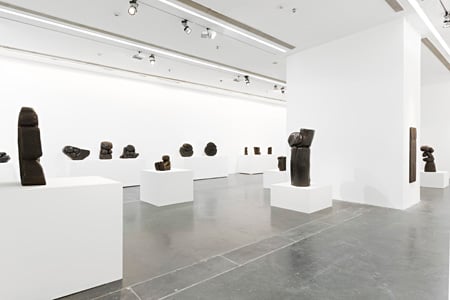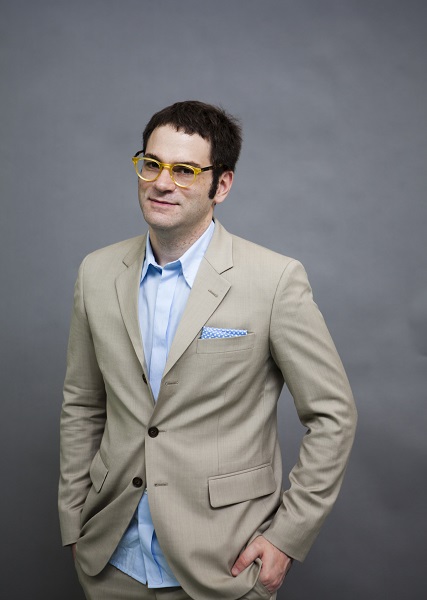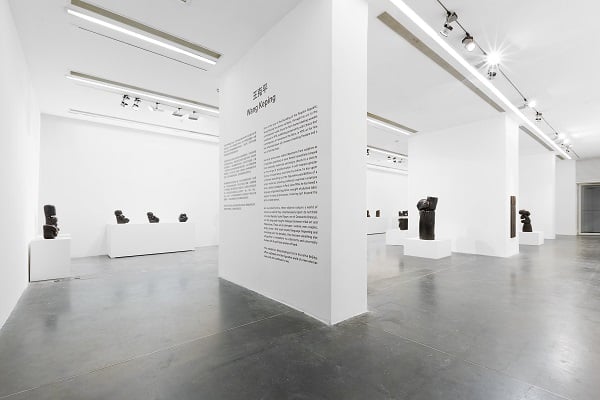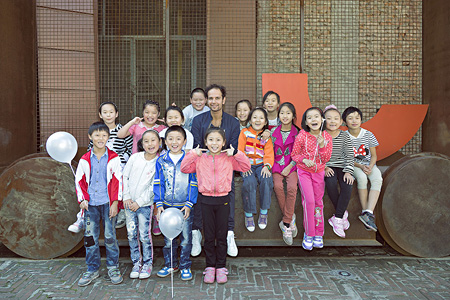Galleries
Interview with Philip Tinari, Director of the Ullens Center for Contemporary Art
artnet sat down with Philip Tinari, director of Ullens Center for Contemporary Art in Beijing.

artnet sat down with Philip Tinari, director of Ullens Center for Contemporary Art in Beijing.

by
Jessica Zhang

In September, artnet’s Jessica Zhang sat down with Philip Tinari, director of Ullens Center for Contemporary Art (UCCA) in the 798 Art District in Beijing.

Philip Tinari, Director of the Ullens Center for Contemporary Art
Jessica Zhang: First of all, congratulations on becoming the curator of the China Focus section of the 2014 New York Armory Show. It will be the first time that The Armory Show is hosting a China Focus section, which is a lot of responsibility for you. What do you think led you to play the curator role for this particular event? What would you like to present for your first appearance?
Philip Tinari: I guess the reason can be traced to my background. I accumulated experience at art fairs when I worked at Art Basel; I used to be an editor of LEAP magazine, and I have been the director of UCCA for two years. Essentially, what I want to build is a platform that provides a comprehensive overview of Chinese Contemporary Art. I feel that America’s understanding of Chinese Contemporary Art has stagnated since 2006, or maybe even since 1998. Without a doubt, many solo exhibitions of Chinese artists have taken place, such as the exhibition tour of Ai Weiwei (Chinese, b.1957), or exhibitions curated by a number of galleries. Yet there is no system, and in fact, it had been a long time since Chinese Contemporary Art has been comprehensively displayed in a public forum. In 2006, when I was working at Sotheby’s, I participated in the first auction of Chinese Contemporary Art, which showcased about 300 artworks. At that time, an art critic for The New York Times described the preview of that auction as the biggest exhibition to summarize the development of Chinese Contemporary Art in the last decade. That being said, China Focus 2014 will be even more concentrated than that preview. I hope to present the most current Chinese Contemporary Art, such as artworks by emerging young artists who participated in the ON/OFF exhibition—a large-scale group exhibition held at UCCA in 2013—alongside works that deal with historical subject matter, such as those by members of The Stars Group, including Huang Rui (Chinese, b.1952) and Wang Keping (Chinese, b.1949). The artwork becomes the most important thing when it comes to organizing an exhibition, and my idea is to present a more comprehensive survey of Chinese Contemporary Art.

Wang Keping, Installation View, photo by Luke Walker, courtesy of UCCA

Wang Keping, Installation View #2, photo by Luke Walker, courtesy of UCCA
JZ: How many galleries will you choose to participate? What do you think the ratio will be of Chinese galleries to international galleries that have opened locations in China, such as Pace and Lehmann Maupin?
PT: I will choose around 15 to 20 galleries. According to the general procedure, I will first think of a list of artists and a list of galleries, or a list of artists featured by particular galleries. Next, I will go talk to each gallery individually. If everything goes as planned, I will then begin to think about how to allocate space.
I think the ratio of domestic galleries to international galleries is not particularly important, but there has to be a balance. This is the most sensitive thing for us: how to appropriately present local galleries on the one hand, and unobtrusively feature international galleries on the other. It actually depends a lot on the artists.
JZ: Many art fairs and organizations around the world simultaneously decided to launch a special “China edition” this year, such as The Armory Show and Art Paris Art Fair. As one of oldest and most prestigious art fairs in the United States, what are the advantages of The Armory Show compared with other, international art fairs? In terms of format, what are you doing differently this year compared to last year?
PT: One of the advantages I think is that The Armory Show is held in New York City, the best city for art. Therefore, I think there’s a lot of significance in holding this fair in New York, and it will definitely draw a large crowd.
I think the biggest difference between this year and last year is that the format will be more like an exhibition. Most of the booths will present a small solo exhibition, instead of what we typically see at art fairs.
JZ: Every year, The Armory Show selects a commissioned artist to design limited-edition artworks. Will you choose one artist this year, or try something new? Will you consider Chinese artists?
PT: The commissioned artist for this year’s Armory Show is Xu Zhen (Chinese, b.1977). This special edition is also an interesting way to incorporate artists’ unique creativity as part of the framework of the fair, making it livelier and more dynamic. These limited-edition artworks will be used to sponsor institutions such as MoMA and local Chinese art institutions.
JZ: Art is still a relatively young industry in China. A large number of the buyers are used to buying artworks from the perspective of investment or speculation, rather than basing their decisions purely on a love of art. As a result, there is usually volatility in the market. Could you please comment on the maturity, sustainability, and development potential of the Chinese art market?
PT: I think that the market has changed a lot over the past years. The feeling of speculation was very prevalent in 2008. After that, the Chinese and Western art markets became more integrated, which is due, on the one hand, to the internal development of the Chinese art market, and on the other hand, to changes in the international art market. For example, the first Art HK in 2008 was a very small art fair. At that time, more and more Western galleries wanted to explore the possibility of the Chinese art market, and Hong Kong was becoming a major platform as a result of the mainland laws and policies.
In addition, Sotheby’s and Christie’s received auction permits in mainland China, and began to organize auction sale events. In terms of collectors, it has been a long-standing tradition for art collectors to become patrons and sponsors of art museums in the West. Take the example of our organization, UCCA: last year, we set up a patrons committee and, despite the fact that we were the first nonprofit organization supported by foreign collectors, we have been witnessing the growing influence of local collectors every year, including corporate ones. The names of the UCCA patrons have increased year by year. Thus, I feel the structure and state of the market have continued to become stronger and more dynamic each year. The art market ecosystem needs various voices and participation—young collectors may only buy the less expensive works, while some enterprises and institutions may buy important new works by Chinese artists.
JZ: What do you think about the status and impact of the Chinese art market in the current international market?
PT: I think that China has already earned a high position in the international Contemporary art market. Of course, if you look at the proportion of Chinese galleries in major international art fairs, or the amount of Chinese artworks included in important auctions, the ratio may still not be very high, perhaps between five and 10 percent. Nevertheless, everyone is aware of China’s importance and has been making an effort to learn more about the Chinese art market. I believe that there will be more opportunities to showcase Chinese Art in the coming years.
JZ: You have a very interesting and unique background—you have international experience and at the same time, have witnessed the rapid growth of Chinese Contemporary Art in the past 10 years. What do you see as the biggest challenge that Chinese Contemporary Art has faced over the past few years? What is the biggest challenge it will face in the future?
PT: The problem in the past was a lack of resources; everyone was competing for very limited options. For instance, if a Taiwanese curator came to mainland China, everyone fought for the chance to schedule an appointment with him or her. This pattern continued until 2006, when three tour buses containing 80-plus people from the MoMA arrived in mainland China. At that point, we realized that Chinese Contemporary Art no longer had to wait for opportunities to present themselves. Of course, the attention from overseas was only one aspect of the many changes that took place. At that time, there were no exhibition spaces, nor was there a healthy market, making it difficult for anyone who was looking for a space to do projects or even survive. However, these kinds of challenges are often helpful in the creation of art, and at that time, many extremely memorable works were being created. Since then, the art market has progressed in the direction of rapid professionalization, which has led to more opportunities and more profitable business models, but it has also created problems. We need to remain vigilant about the system becoming stronger than the artistic creation itself.
JZ: Ullens Center for Contemporary Art is a leading nonprofit international art institution and has been a landmark in the 798 Art District since 2007. What is the biggest challenge you have encountered in the past? What is the strategic goal of your organization?
PT: We are currently in the phase of stabilization. The center was founded by two Belgian collectors, who established the Contemporary Art space when no one had the ability to create a platform on such a large scale. A lot of time and money have made the center what it is today. Over the past six years, we have experienced many changes and encountered numerous challenges, and even considered giving up entirely. However, we kept trying and we pulled through. We have, without a doubt, built our public influence and authority in the field of Chinese Contemporary Art. Our current challenge lies in figuring out how to maintain the sustainability of our organization. Therefore, we don’t have plans to open branches in other parts of China. Every day we think about how to self-finance all of our costs, which is a challenge faced by many private art museums and cultural institutions, and we continue to make great progress every year. Sponsorship from the Ullens family has been reduced to around 40 percent of spending, and the remaining 60 percent comes from various other channels, which does not involve selling artwork. Between each exhibition, we rent out the space for private business use. The revenue generated by a three-day jewelry fair, for example, is enough to create an entire exhibition. Space, retail, and sponsorship are all important sources of income for us.
JZ: We are now at the age of “big data,” where technology develops rapidly and new art e-commerce platforms pop up each year. Can you comment on this trend? How do you think nonprofit art institutions such as UCCA should respond to this?
PT: I think it is a great thing for the artist, as it completely eliminates the information gap.
There are various sources of information that young artists can explore. When we look back at previous generations who didn’t have access to this kind of information, it feels very strange and far away. Overall it is a good thing, but it is important to figure out how to filter the information. I think art museums are still necessary for people to have the physical experience of seeing artworks in person. We still believe in the power of art and the irreplaceable energy that we can only experience when we see it in person. We utilize social media channels and our website to communicate with our audience, but I believe that the most essential element is the physical experience. Therefore, this year we have arranged an exhibition of Tino Sehgal (British/German, b.1976), which will not allow any media presence at all. Everything has to be experienced in person.

Tino Sehgal and Participants, courtesy of UCCA
JZ: Do you collect artworks yourself? What types of artists interest you the most?
PT: I wouldn’t call it collecting, but I do keep an eye on talent. When I curated the ON/OFF exhibition last year, I did a lot of research and spent a whole summer familiarizing myself with the artists. I think the new generation—what I call the “ON/OFF group”—is very interesting. I think they are the first generation of truly international artists in China, which does not only refer to their international popularity, but also their artistic practices, which tend to absorb a lot of different elements. Because of digitalization, a new artistic language had been created in the past five years. Although I cannot foresee the development and trends of the future, I am still looking forward to, and very optimistic about, the future of the Chinese artist.
JZ: Tino Sehgal and Taryn Simon (American, b.1975) are both internationally recognized artists who have held solo exhibitions in many well-known galleries and institutions. How did you select these Western artists when you were planning the shows?
PT: Our only rationale is to give our audience an aesthetic experience. We did not found the institution to promote any particular artist or increase their market value.
The scheduled opening date for these exhibitions was on September 26 because the following week was Golden Week, a Chinese national holiday. That time of year tends to draw the biggest crowds.
In terms of the selection of Chinese artists, I usually think about how to utilize the power of our organization to bring attention to them. Therefore, I typically select artists who I think are important, but haven’t yet received enough recognition and attention. In terms of selecting overseas artists, I think about how it will be received in Beijing, and in China in general. I consider whether the art will be understood and what it does for its audience. For example, Tino’s art, which leaves no trace of commoditization, when placed in this materialistic environment, establishes its own frameworks. Similarly, Taryn’s art, particularly this series of works, explores many different stories using a single methodology, and all the information you need is already present in his images. I don’t want to curate exhibitions that only a few people can understand. Once you step into a space, no matter who you are or where you come from, you need to be able grasp the basic logic of the works within a couple of minutes: only under these circumstances can art have an effect on you.
This is how our institution works—different spaces are suitable for different exhibitions. When I first arrived here in 2011, everyone thought UCCA was going to shut down, and we tried hard to curate a lot of shows. There was an opening nearly every month, and sometimes even every few weeks. A major change over the past two years is that we have been taking more time to plan the shows and make better preparations so that we can generate a larger audience.
JZ: Looking ahead to the upcoming exhibitions at UCCA in 2014, what can we expect?
PT: We have confirmed all of the exhibitions for next year. The first exhibition will be a large-scale solo exhibition of a 1970s artist. Next summer, we will participate in a Contemporary Art exchange, hosting an exhibition of Brazilian Modern Art, and bringing our exhibition to Sao Paulo at the same time. It is strange that two such large countries have never hosted collaborative exhibitions of Contemporary Art before. Over the next year, there will be more international exhibitions than ever before.
Current Exhibitions:
Wang Keping, September 9, 2013–January 5, 2014
Taryn Simon, A Living Man Declared Dead and Other Chapters I–XVIII, October 10, 2013–January 5, 2014
This interview was originally conducted in Chinese, and was translated by Ning Ding and Jessica Zhang.